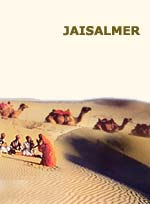 JAISALMER- Rising from the heart of the Thar Desert like a golden mirage is the city of Jaisalmer. A commanding fort etched in yellow sandstone stands, with all its awesome splendor, dominating the amber-hued city.
JAISALMER- Rising from the heart of the Thar Desert like a golden mirage is the city of Jaisalmer. A commanding fort etched in yellow sandstone stands, with all its awesome splendor, dominating the amber-hued city.
The city has an interesting legend associated with it, according to which, Lord Krishna-the head of the Yadav Clan, foretold Arjuna that a remote descendent of the Yadav Clan would built his kingdom atop the Trikuta Hill. His prophecy was fulfilled in 1156 A.D. when Rawal Jaisal, a descendent of the Yadav Clan and a Bhatti Rajput,abandoned his fort at Lodurva and founded a new capital -Jaisalmer,perched on the Trikuta Hill.
Bahti Rajputs of Jaisalmer were fedual chiefs who lived off the forced levy on the caravans laden with precious silks and spices that crossed the territory enroute Delhi-or-Sind. These caravans earned the town great wealth.
For years Jaisalmer remained untouched by the outside influences. The rise of shipping trade and the port of Mumbai saw the decline of Jaisalmer. But the desert fortress, that seems to be straight out of the ‘Tales of the Arabian Nights’ still enchants.
The life within the citadel conjures up images of medieval majesty visible in its narrow lanes stewn with magnificent palace, havelis, temples and of course skilled artisans and ubiquitous camels.
The setting sun turning Jaisalmer into a beautiful golden brown is a spectacular sight.
The perfect time to visit the golden city is during the Desert Festival, held in Jan/Feb. every year, when the city reverberates to the sound of melodious tunes and rhythms.
 Folk dances, exciting competitions an contests, especially the turban-tying contest. Mr. Desert contest and camel races enliven the festivities. Colorful craft bazaars are set up for the occasion and a sound and light spectacle is organized wit folk artists performing against the splendid backdrop of the famous Sam sand dunes on the full moon night. Surely a not-to-be missed event.
Folk dances, exciting competitions an contests, especially the turban-tying contest. Mr. Desert contest and camel races enliven the festivities. Colorful craft bazaars are set up for the occasion and a sound and light spectacle is organized wit folk artists performing against the splendid backdrop of the famous Sam sand dunes on the full moon night. Surely a not-to-be missed event.
PRIME SITES:
The Fort: The golden hued fort is a sentinel to the bleak desertscape from its 80 metre high perch on the hill,housing the entire township within its ramparts.It has an enchanting cow-web of narrow lanes dotted with some lovely havelis,three beautifully sculptured Jain Temples of the 12th-15th century A.D. and five interconnected palaces.The fort is approached through four gateways-Akhaiyal,Ganesh Pol,Suraj Pol and Hava Pol.
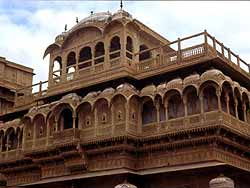 Manak Chowk and Havelis: A main marketplace outside the fort leads to the narrow lanes dotted with famous havelis.
Manak Chowk and Havelis: A main marketplace outside the fort leads to the narrow lanes dotted with famous havelis.
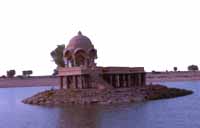 Gadsisar Lake: A scenic rain water lake with numerous beautiful shrines around and a spectacular avian variety. The lake is an idyllic spot for outings.
Gadsisar Lake: A scenic rain water lake with numerous beautiful shrines around and a spectacular avian variety. The lake is an idyllic spot for outings.
Tazia Tower: A pagoda like structure looming up from the ‘Badal Mahal’ with beautiful ‘Taazias’-ornately decorated bamboo,paper and tinsel replicas of a bier, carried out in procession during Moharram by the Muslims.
Havelis: Some of the most exotic mansions or havelis,all intricately latticed are strew all over Jaisalmer-each with a different facade.
Nathmalji-ki-Haveli: The late 19th century haveli with intricate architecture a display of sheer craftsmanship. The justify and right wings of the mansion which were carved by two brothers are not identical but very similar and balanced in design. The interior walls are ornate with splendid miniature paintings.
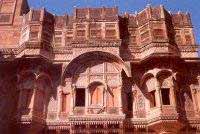 Patwon -ki-Haveli: The most elaborate and magnificent of all the Jaisalmer havelis. It has exquisitely carved pillars and extensive corridors and chambers.One of the apartments of this five storey high haveli is painted with beautiful murals.
Patwon -ki-Haveli: The most elaborate and magnificent of all the Jaisalmer havelis. It has exquisitely carved pillars and extensive corridors and chambers.One of the apartments of this five storey high haveli is painted with beautiful murals.
Salim Singh-ki-Haveli: This 300 year old haveli of Jaisalmer’s Prime Minister to Maharaja Rawal Gaj Singh-Salim Singh, has a beautiful blue cupola roof with superbly carved brackets in the form of peacocks.This extraordinary mansion in yellow stone is covered with intricate carvings and has an elaborate projecting balcony on the top storey.The mansion is one of the most notable of the array of havelis.
Jain Temple: The fort has three exquisitely carved jain temples dedicated to the Jain Tirthankars-Rishabhdev,Sambhavnath and Paraswanath.
Gyan Bhandar or Library: Some of the oldest manuscripts of India are found in this library established as a part of Jain temples.
EXCURSIONS
Lodurva (16 km): The ancient capital of Jaisalmer and an important pilgrim spot of the Jain community with some magnificent Jain temple. “Toran’ or the ornate arches at the main entrance and splendid carvings are noteworthy. A ‘Kalptaru’ or a divine tree within is the main attraction of the temple
Wood Fossil Park, Aakal(17 kms): Lying on the Barmer Road , this park takes you back to the Jurassic period (when the whole Thar region lay under the sea) with 180 million year old fossils – the geological landmarks for the study of the Thar Desert.
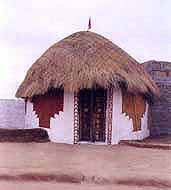 Sam Sand Dunes(42 km): No trip to Jaisalmer is complete without a trip to the most picturesque dunes of Sam. The ripples on the wind -caressed dunes, that create an enchanting mirage, are surely a delight for a trigger -happy photographer.
Sam Sand Dunes(42 km): No trip to Jaisalmer is complete without a trip to the most picturesque dunes of Sam. The ripples on the wind -caressed dunes, that create an enchanting mirage, are surely a delight for a trigger -happy photographer.
Various cultural programmes are organized against the backdrop of these fascinating sand dunes. Exciting camel safaris allow you to get the real feel of the desert on the camel back.
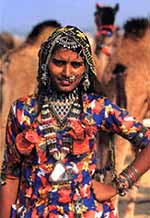 Desert National Park (45 km): The landscape of the Desert National Park is dominated by rolling sand dunes and scrub covered hills. The prominent fauna of the park includes black buck , chinkara, desert fox and the great Indian bustard.
Desert National Park (45 km): The landscape of the Desert National Park is dominated by rolling sand dunes and scrub covered hills. The prominent fauna of the park includes black buck , chinkara, desert fox and the great Indian bustard.
Amar Sagar (5 km) : A pleasant garden beside a lake with mango and other fruit trees. Beautifully carved Jain temples add to its splendor.
Bada Bagh (6km.) : A fertile oasis on the bank of an artificial lake. Much of the city’s fruits and vegetables are grown here. Surrounded by dense trees are the royal cenotaphs with beautifully carved ceilings and equestrian statues of the former rulers.
Mool Sagar(18km.) : The pleasant shady grove is a perfect picnic spot during summers.
Barmer (155 km): A tiny desert town renowned for its hand block printing industry,carved wood furniture,colorful costumes and amiable folks.